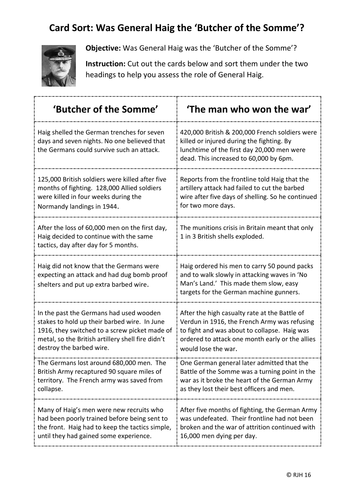
This tried and tested card sort looks at the controversial topic of General Haig's leadership during the Battle of the Somme. Students are given two heading cards labelled 'Butcher of the Somme' and the 'Man who won the war.' However, depending upon how you decide to use them you could change them to 'evidence for and 'evidence against' as the document is in word. In addition to the headings cards, students are given 14 statements to sort through. These are based on the latest research on the topic. This activity is suitable for a wide range of learners and could be used as the basis of an assessment task or extended writing activity.
Aims & Objectives
Theme: Why was there a stalemate on the Western Front?
Know: What tactics did General Haig use at the Battle of the Somme in 1916?
Understand: Why did the Battle of the Somme end in a stalemate?
Evaluate: Was General Haig the 'Butcher of the Somme?
WILF: What Am I Looking For?
Identify and describe- What happened during the Battle of the Somme in 1916?
Explain - Why did Haig's tactics fail to achieve a breakthrough?
Analyse - How far was Haig's responsible for the failure to break through in 1916?
Professional Knowledge
For those of you who are new to the profession, this topic is controversial for a number of reasons. Firstly, the leadership of the British Army during the war is traditionally described by some historians as 'lions led by donkeys.' Please note that this interpretation first grew out a dissatisfaction with the Treaty of Versailles and the concept that the First World War would be the 'War to end all wars' in the 1930's. Clearly by then, many of the sacrifices appeared to have been in vain with the rise of Hitler and the threat of war. However, in the immediate aftermath of the First World War, Haig was seen as a hero. He was also the man who set up the Royal British Legion and began the first poppy appeal. Secondly, this topic is controversial for many of our Australian cousins whose sense of national identity grew out of their frustration and anger over the disaster at Gallipoli. This has led to feeling that the British tactics were a complete failure in all theatres of war and has led to the writing of some pretty bad popular history by Australian tour guides like John Laffin in his book ‘British Butchers and Bunglers of WW1' to almost justify the Republican Movement in Australia. History as always is controversial. Historians create a hierarchy of facts to suit their own interpretations. This exercise gets students to have a go at creating their own!
I have also created a PowerPoint to accompany this topic, which can be downloaded separately or as part of a discounted package.
Kind Regards
Roy
Aims & Objectives
Theme: Why was there a stalemate on the Western Front?
Know: What tactics did General Haig use at the Battle of the Somme in 1916?
Understand: Why did the Battle of the Somme end in a stalemate?
Evaluate: Was General Haig the 'Butcher of the Somme?
WILF: What Am I Looking For?
Identify and describe- What happened during the Battle of the Somme in 1916?
Explain - Why did Haig's tactics fail to achieve a breakthrough?
Analyse - How far was Haig's responsible for the failure to break through in 1916?
Professional Knowledge
For those of you who are new to the profession, this topic is controversial for a number of reasons. Firstly, the leadership of the British Army during the war is traditionally described by some historians as 'lions led by donkeys.' Please note that this interpretation first grew out a dissatisfaction with the Treaty of Versailles and the concept that the First World War would be the 'War to end all wars' in the 1930's. Clearly by then, many of the sacrifices appeared to have been in vain with the rise of Hitler and the threat of war. However, in the immediate aftermath of the First World War, Haig was seen as a hero. He was also the man who set up the Royal British Legion and began the first poppy appeal. Secondly, this topic is controversial for many of our Australian cousins whose sense of national identity grew out of their frustration and anger over the disaster at Gallipoli. This has led to feeling that the British tactics were a complete failure in all theatres of war and has led to the writing of some pretty bad popular history by Australian tour guides like John Laffin in his book ‘British Butchers and Bunglers of WW1' to almost justify the Republican Movement in Australia. History as always is controversial. Historians create a hierarchy of facts to suit their own interpretations. This exercise gets students to have a go at creating their own!
I have also created a PowerPoint to accompany this topic, which can be downloaded separately or as part of a discounted package.
Kind Regards
Roy
Get this resource as part of a bundle and save up to 49%
A bundle is a package of resources grouped together to teach a particular topic, or a series of lessons, in one place.
Something went wrong, please try again later.
This resource hasn't been reviewed yet
To ensure quality for our reviews, only customers who have purchased this resource can review it
Report this resourceto let us know if it violates our terms and conditions.
Our customer service team will review your report and will be in touch.
£3.50
